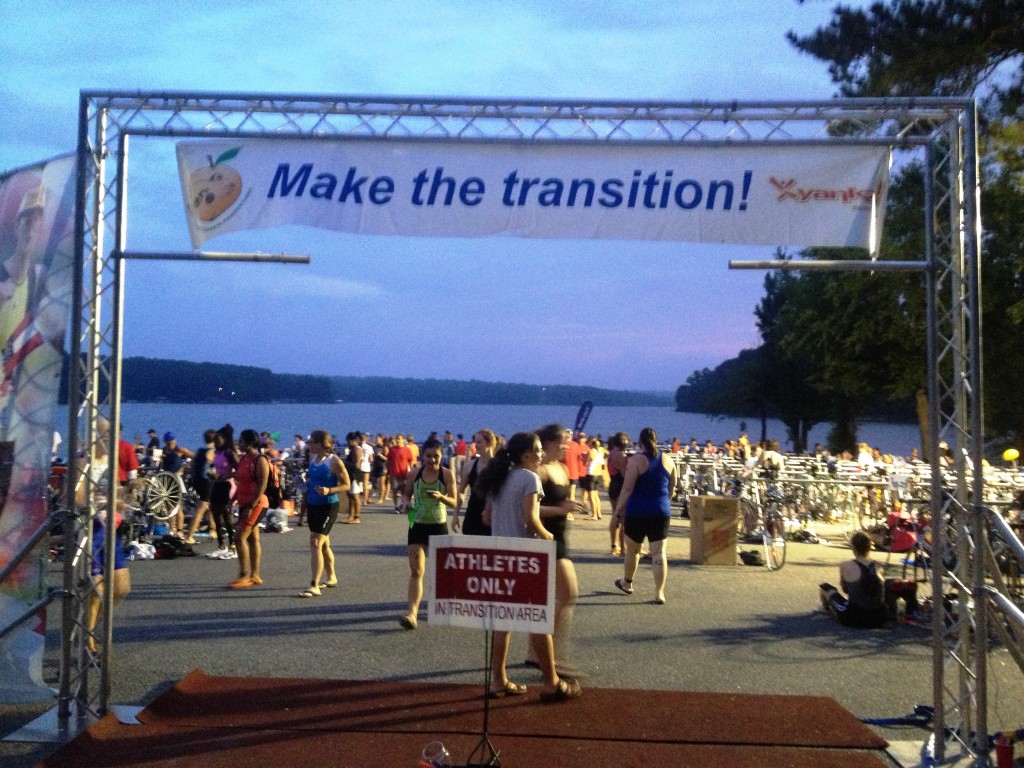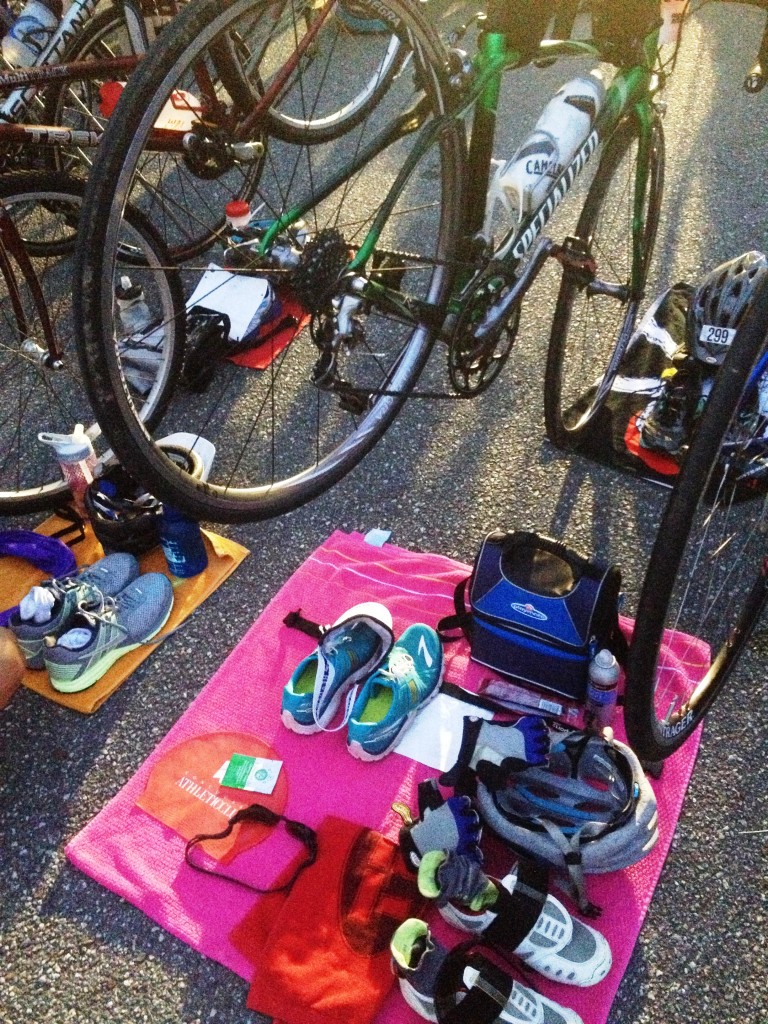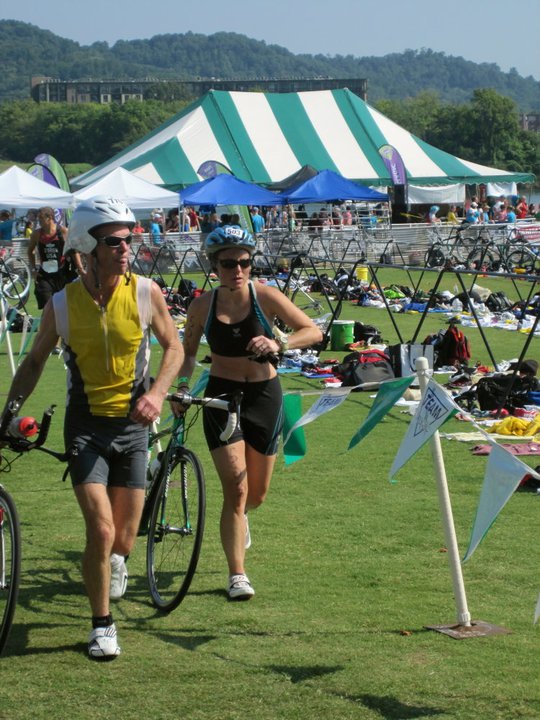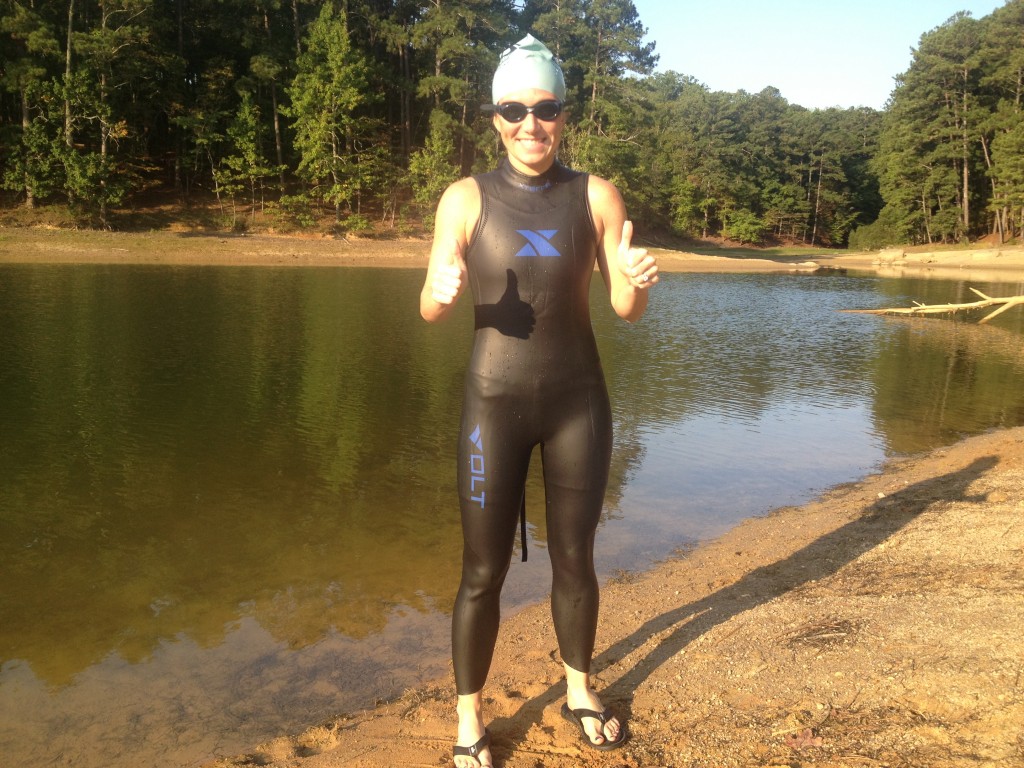Triathlon Transition Tips to Become a Faster Triathlete
As an endurance athlete, I’m constantly looking for ways to become a more efficient and faster swimmer, cyclist and runner. From reading expert tips shared by coaches and high performing athletes to doing drills, intervals, speed work and race-day simulation workouts, my purpose is to train smart, race strong and consistently improve. But did you know that when it comes to triathlons, we have an opportunity to shave seconds – maybe even minutes – off our time that we often overlook?
It’s true. Enter transitions.
Transitions are the portions of a triathlon between each of the three sports (2 transitions total) that allow you to quickly prepare for the next portion of the race. T1 is the first transition between the swim and the bike and T2 is the second transition between the bike and the run. If we spend countless hours honing our swimming, biking and running, shouldn’t we also be practicing our transitions? The answer is yes.

I must sheepishly admit that I neglect transition practice. I rehearse it in my head but rarely practice transitioning before race day. Given that there are so many factors we can’t control on race day, we shouldn’t allow our lack of transition practice to be one of them. Today I’m sharing my triathlon transition tips to successfully master T1 and T2.
Triathlon Transition Tips
Practice. Transition practice is frequently overlooked. But like anything, the more you practice transitions, the faster and more efficient you will become. Prior to race day, be sure to spend some time doing several mock transition sessions. Know where you will lay everything out (more on that below) and the sequencing in which you will put everything on. It sounds simple, but knowing your sequencing will prevent fumbling and wasted time. If you are doing some open water swims, bring all your gear and practice running out of the water, putting all your bike gear on and running out. Then, practice coming in with your bike and transitioning for the run. If you want to get really hard core, video you’re yourself doing your transition practice and watch to see where you are encountering errors or challenges so you can fix them. Confidence is preparation. Help boost your confidence by going into race day prepared for your transitions.
Walk through your transitions in the transition area the day before the race. All athletes should have access to the race transition area the day before race day. Not only should you familiarize yourself with where your bike will be situated, but you should practice walking from the swim exit to the transition entrance to your bike and out the bike exit. Then, walk the bike entrance to your transition area and out the run exit. When your adrenaline is going on race day, it can be confusing if you haven’t mapped out your game plan. Mentally rehearse the exits, entrances and finding your transition area. This will help reduce unwelcome uncertainty on race day.
Identify a visual cue to help you find your transition area quickly. While mapping out your transition area the day before the race and on race morning, find a visual cue that will help you easily identify your bike rack and row. Perhaps there is a big tree, a fence post or promotional flag. Find something that will help you spot where to go when you are in the transition area. When races are on pavement, I bring a piece of chalk with me and write the first initial of my name on the ground by my bike so I can see it as I run. First timers often tie Mylar balloons to the bar near their bike or ribbon.
Arrive early on race morning to secure the best space. On race morning, your nerves will be kicking in and the butterflies will be dive-bombing in your stomach. Reduce added stress from rushing in the transition area by arriving early. Arriving early will also help ensure you get a good place on your bike rack and have adequate space to lay out all your transition items. It’s always unsettling when you arrive late and barely have a patch of land to place all your gear by your bike. Control the things you can control. (And remember, never touch or move anyone else’s belongings in transition.)
Strategically set up your space to create the fastest transition. Below are some basic guidelines for laying out your gear and sequencing your moves for sprint, international, Olympic and half Ironman distance races. (The transition situation changes quite a bit when you get to the full Ironman level.)

- Find your number in your transition area and rack your bike by standing behind it and placing the front of your seat over the bar so your back wheel is off the ground. The free space under your wheel will serve as your transition space.
- Place all the fuel and hydration you’ll need for the bike on your bike so it is ready to go – bottles in their cages, fuel in your bike bag/bento box. You don’t want to waste time fumbling with that stuff in transition.
- Use a brightly colored towel that will be easy for you to spot on the ground under your back wheel. You can use/buy a triathlon mat but I think that is unnecessary. I typically fold mine in half or in thirds to provide adequate room for those around me. You will use your towel to place all your stuff (only what you need during the race) on as well as to wipe your feet dry after the swim.
- Place your cycling shoes on the front of the towel where they will be easy for you to access. Make sure all the straps are unbuckled and ready for you to slip your feet into. I highly recommend wearing cycling shoes that only have one strap (as opposed to 3) to save time putting them on and getting them off. If you’re wearing socks with your cycling shoes, place those on top of the shoes. If you’re going sockless (which saves significant time but I’m not brave enough for that), be sure to put body glide/Aquaphor around the edges of your shoes and baby powder inside to prevent blisters. Some athletes choose to clip their shoes on their bike and secure them with rubber bands to put on as they mount the bike to save time in transition. I simply haven’t mastered this yet, but it can save many precious seconds. If you’re using a bike that doesn’t have clip-pedals, position your running shoes and socks as mentioned above instead.
- Place your helmet either next to your shoes or on the aero bars of your bike, upside down (round, hard side down) so you can easily put it on your head and fasten the strap. Some people like to put their sunglasses (be sure they are open and ready to put on) on their helmet to put glasses on first and then helmet, while others prefer to adhere them onto their bike and put them on once they’re settled on their bike. Do whatever works best for you, but be sure to have sunglasses.
- If you’re using cycling shoes, which I hope you are, place your running shoes next to your cycling shoes for T2. Use tie-less laces like Yankz or another similar brand so that you can easily slip your feet in without having to tie your shoes (saves a lot of time).
- If you wear a hat or visor (which is a must-have for me), place it on top of or in front of your running shoes. It should be pre-adjusted to easily slip onto your head. I highly recommend the Head Sweats Cool Max Supervisor which requires no adjusting.
- For longer distance triathlons, place any hand-held hydration and nutrition next to your shoes to take with you when you exit transition. I have a very small cooler that I fill with ice and keep my Nathan Hydration or Amphipod hand held bottles in so they are still cold by the time I’m ready to run. I put GUs in the pocket so they are already attached. If you won’t be carrying hydration, put your GUs or other nutrition of choice in your shoe or on top of your shoe so you doing forget it.
- Lay your race belt (a belt that clips your bib number to it) face-down so you can grab the ends and fasten it as you are running out of transition. Do not stand in your transition area while fastening it. Take it with you as you are running out and fasten it while you’re moving.
- When you return from both the swim and the bike, be sure to remove the items you no longer need (e.g. goggles, swim cap, wetsuit, bike helmet, bike gloves, bike shoes, etc.) and place them back on your transition towel. Try to take as many things off while you’re moving as possible (e.g. your goggles, swim cap and wet suit should be off by the time you reach transition area. You can start taking bike gloves off as you are finishing the bike and unsnap helmet as soon as you dismount from your bike.)


Cozy up to the strippers. Yes, guys. You heard me right. For races where wetsuits are allowed, there should be wetsuit strippers waiting for you as you enter the transition area. Use them! It can take time to get your wetsuit off on your own, and these fabulous volunteers can whip it off your body in a matter of seconds. As you are running out of the water, unzip your suit and take your arms out so it is below your waist. Lay on your back with your hips tilted up. The strippers will grab your suit and whisk it off of you. Take it from them and put it back on your transition towel. Trust me, they save you time.

Avoid sitting. This is actually a new strategy for me this year. I know, I know. I should have been doing this earlier, but I’ve always sat down in T1 after the swim to put on my shoes and socks (and to sometimes pee on my towel, oops!). This adds more time. When you come into T1, put your helmet and sunglasses on as you are wiping your feet on your towel like you would a doormat. Then, put on your socks and shoes while standing and GO! Small details like this can make a big difference, but be sure to practice this before race day.
With all that being said, my Beach2Battleship Half Ironman (which is 16 days away, not that I’m keeping track) has T1 and T2 in two different areas and is following more of an Ironman style approach since a full will also be happening simultaneously in which we have to put all our transition gear into bags that we will receive. I’m going to practice putting my gear in bags and dumping it out to put on this week. Just when I thought I had transitions down, I enter a race where things are totally changed up. I’ll be sure to bring you back my new experience with that.
Want to follow me through all my half Ironman race day adventures? Here’s where you can find me every day talking about training, preparation and race day:
- Twitter: @rUnladylike
- Facebook: https://www.facebook.com/runladylike
- Instagram: http://instagram.com/runladylike/
- Daily Mile: http://www.dailymile.com/people/jesica
- Pinterest: https://pinterest.com/JesicaD/
If you liked this post, check out these while you’re here …
Triathlon Race Day Checklist
Transitioning to Triathlon: What Every Runner Needs to Know
Mastering Open Water Swims
What other triathlon transition tips would you add to this list? Any transition horror stories you have to share with us?



Comments
Great time-saving tips! I want to do my first tri sometime next year, so I’m a total noob.
Love this! Have you practiced peeing ON the bike? I never thought I would be able to pee on something that I paid over $1,500 for… but during the bike portion at Augusta I was having a much stronger ride than my 1st HIM but had to pee so badly I couldn’t see straight, and no matter what I did, I could not go on the bike!! Ended up having to stop at an aid station and lost valuable time. That said I would either 1. make sure you can go on the bike or 2. continue to sit on your towel and pee in transition! 🙂
Hi Amber! I have not yet peed while on the bike but I totally would if needed 🙂 I’ve been told that you should lift yourself off the seat and tilt slightly to the side and let it rip. At Augusta last year, I peed in the porta potty in transition between the bike and run. It took me about 90 seconds but I was still able to get out of transition in about 4 minutes. I’ll have to see what happens this year at B2B. I’d love to save that time. I’m also known for peeing on the run so that is an option. If you choose to do that, I like to do it a little at a time so it soaks into your chamios vs. running down your legs and into your shoes. The smell never comes out of your shoes 🙁
I’ve been standing for most of my races but then I heard someone say they sat down and were a lot faster than me. I must be the slowest shoe putter onner of all time! lol! thanks for the tips! I def need to work on transitions.
I think the key is simply to practice. If we’re practiced up, we should be faster either way 🙂
Great tips.
One more tip: bring a small water bottle and if you are wearing socks on the bike possibly a small towel. If the walk from the swim to T1 is sandy, you can use it to get the sand off you feet quickly
Great Blog! Looking for a transisition bag any suggestions?
Hi Mary! Thanks so much for stopping by. I love the Ogio Endurance bag. Apera also makes some great everyday bags for gear. Best of luck with your training!